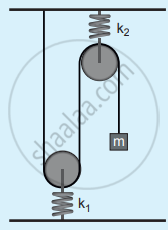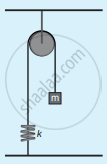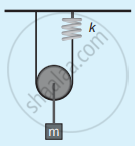Advertisements
Advertisements
प्रश्न
Discuss the simple pendulum in detail.
उत्तर
Simple pendulum: A pendulum is a mechanical system which exhibits periodic motion. It has a bob with mass m suspended by a long string (assumed to be a massless and inextensible string) and the other end is fixed on a stand. At equilibrium, the pendulum does not oscillate and hangs vertically downward. Such a position is known as the mean position or equilibrium position. When a pendulum is displaced through a small displacement from its equilibrium position and released, the bob of the pendulum executes to and fro motion. Let l be the length of the pendulum which is taken as the distance between the point of suspension and the center of gravity of the bob. Two forces act on the bob of the pendulum at any displaced position.

(i) The gravitational force acting on the body `(vec"F" = "m"vec"g")` which acts vertically downwards.
(ii) The tension in the string `vec"T"` which acts along the string to the point of suspension.
Resolving the gravitational force into its components:
(a) Normal component: The component along the string but in opposition to the direction of tension, Fas = mg cos θ
(b) Tangential component: The component perpendicular to the string i.e., along the tangential direction of an arc of the swing, Fps = mg sin θ
Therefore, The normal component of the force is, along the string,
T − Was = `"m""v"^2/"l"`
Here v is speed of bob
T − mg cos θ = `"m""v"^2/"l"`
From the figure, we can observe that the tangential component Wps of the gravitational force always points towards the equilibrium position i.e., the direction in which it always points opposite to the direction of displacement of the bob from the mean position. Hence, in this case, the tangential force is nothing but the restoring force. Applying Newton’s second law along tangential direction, we have
`"m"("d"^2"s")/("dt"^2) + "F"_"ps" = 0 ⇒ "m"("d"^2"s")/("dt"^2) = -"F"_"ps"`
`"m"("d"^2"s")/("dt"^2)` = − mg sin θ ..........(1)
where s is the position of bob which is measured along the arc. Expressing arc length in terms of angular displacement i.e.,
s = lθ ...........(2)
then its acceleration, `("d"^2"s")/"dt"^2 = "l"("d"^2θ)/"dt"^2` ............(3)
Substituting equation (3) in equation (1), we get
`"l"("d"^2θ)/"dt"^2` = − g sin θ
`("d"^2θ)/"dt"^2 = - "g"/"l" sin θ` .........(4)
Because of the presence of sin θ in the above differential equation, it is a non-linear differential equation (Here, homogeneous second order). Assume “the small oscillation approximation”, sin θ ≈ θ, the above differential equation becomes a linear differential equation
`("d"^2θ)/"dt"^2 = - "g"/"l" θ` ...........(5)
This is the well-known oscillatory differential equation. Therefore, the angular frequency of this oscillator (natural frequency of this system) is
`ω^2 = "g"/"l"` ..........(6)
∴ `ω = sqrt("g"/"l")` in rad s−1 .......(7)
The frequency of oscillations is f = `1/(2π) sqrt("g"/"l")` in Hz .........(8)
and time period of oscillations is T = `2π sqrt("l"/"g")` in second .........(9)
APPEARS IN
संबंधित प्रश्न
Two bodies A and B whose masses are in the ratio 1 : 2 are suspended from two separate massless springs of force constants kA and kB respectively. If the two bodies oscillate vertically such that their maximum velocities are in the ratio 1 : 2, the ratio of the amplitude A to that of B is
The time period for small vertical oscillations of block of mass m when the masses of the pulleys are negligible and spring constant k1 and k2 is

An ideal spring of spring constant k, is suspended from the ceiling of a room and a block of mass M is fastened to its lower end. If the block is released when the spring is un-stretched, then the maximum extension in the spring is
A pendulum is hung in a very high building oscillates to and fro motion freely like a simple harmonic oscillator. If the acceleration of the bob is 16 ms−2 at a distance of 4 m from the mean position, then the time period is
Write down the equation of the time period for the linear harmonic oscillator.
Explain the horizontal oscillations of a spring.
Describe the vertical oscillations of a spring.
Write short notes on the oscillations of the liquid column in the U-tube.
A piece of wood of mass m is floating erect in a liquid whose density is ρ. If it is slightly pressed down and released, then executes simple harmonic motion. Show that its time period of oscillation is T = `2π sqrt("m"/("Ag"ρ))`
Compute the time period for the following system if the block of mass m is slightly displaced vertically down from its equilibrium position and then released. Assume that the pulley is light and smooth, strings and springs are light.


